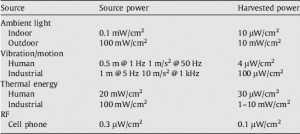Systems that harvest ambient energy on an anticipated basis do not always have a 1-to-1 correlation between when they are active and operating and when there is enough ambient energy to harvest. These systems must include mechanisms to not only harvest and convert the ambient energy, but they must also be able to store and manage their energy store. Energy storage is essential to allow systems to continue to operate during periods of insufficient ambient energy. Energy storage devices can also enable a system to support instant-on capabilities because the system does not have to be able to harvest enough energy from the environment to start operation.
Like many emerging technologies, including touch screens, fully integrated modules may integrate component parts, such as the harvesting transducers and storage technologies, from different companies within the same module. As the energy harvesting device market matures, designers will have access to more options that are fully integrated systems. For now, many of the fully integrated options available to designers include components from multiple companies.
The different types of storage technologies appropriate for energy harvesting applications include thin film micro-energy storage devices, supercapacitors, lithium-ion or lithium polymer batteries, high capacity batteries, and traditional capacitors. Capacitors are able to support applications that need energy spikes. Batteries leak less energy than capacitors, and they are more appropriate for applications that need a steady supply of energy. Thin-film energy storage cells support high numbers of charge/discharge cycles.
(Caption: Rechargeable and non‐rechargeable storage technologies. Cymbet, Infinite Power Systems (IPS), Cap-XX, Saft, and Tadiran are listed as some of the companies providing different storage technologies (source: Adaptive Energy).)
The table documents some of the companies providing storage devices as well as the voltage and maximum current levels that these different technologies support. Energy density is the amount of energy stored per unit mass. The higher a device’s energy density, the larger the amount of energy it can store in its mass. Power density is the maximum amount of power that the device can supply per unit mass. The higher a device’s power density, the larger the amount of power it can supply relative to its mass.
In addition to the energy and power density for each type of storage technology, the temperature ranges that your application will operate in will affect the appropriateness of one approach versus another. For example, in high temperature environments, a lithium polymer battery is generally not a good choice, while for low temperature environments, thin film batteries exhibit lower maximum current ratings. Another consideration as to which storage technology to use relates to the anticipated number of charge/discharge cycles you will subject the device to. For example, a designer using a rechargeable storage approach, such as a battery or capacitor, may run into trouble if the storage mechanism is unable to maintain sufficient performance characteristics while undergoing high numbers of charge/discharge cycles.
The purpose of the energy storage component in an integrated energy harvesting module is to accumulate and preserve the energy captured by the harvester and conversion electronics. In order to deliver maximum storage efficiency, designers should couple the storage technology with the conversion electronics to maximize the effectiveness of storing the energy charge coming from the harvester component. Lastly, for many applications, the storage component should exhibit a slow leakage characteristic so that it can store energy for long periods to accommodate the periods of energy starvation that the system may experience.
If you would like to be an information source for this series or provide a guest post, please contact me at Embedded Insights.
[Editor's Note: This was originally posted at the Embedded Master]







